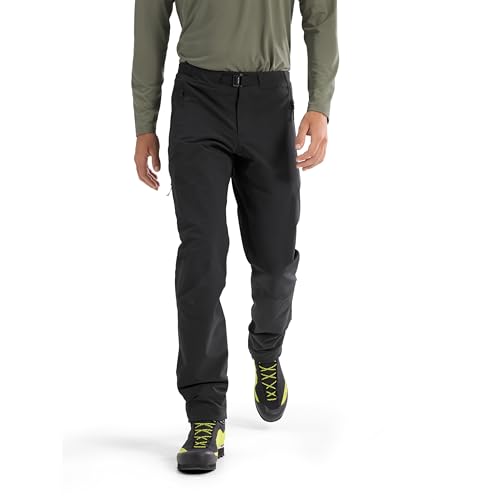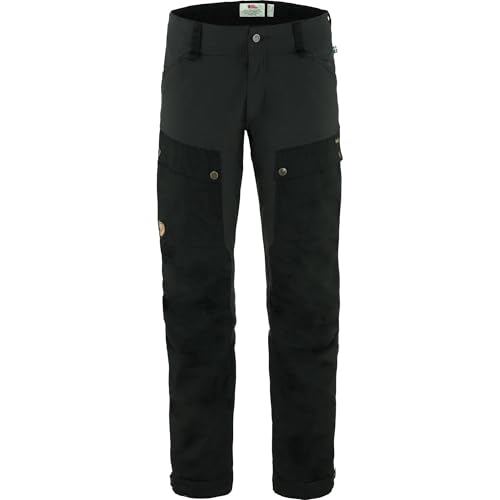Winter backpacking demands gear that can handle the elements without sacrificing comfort or mobility. The right pair of pants is your first line of defense against biting winds, freezing rain, and deep snow. They need to keep you dry, warm, and protected while allowing for the full range of motion required for challenging terrain.
From waterproof hardshells to breathable softshells and insulated options, the market offers a specialized pant for every winter condition. This roundup cuts through the noise to bring you the top-performing winter hiking pants for 2025, designed to keep you focused on the trail ahead, no matter what the forecast brings.
Our Top Picks for Winter Hiking Pants
- Arc’teryx Gamma AR Pant Men’s
- Columbia Men’s Bugaboo™ II Pant
- Outdoor Research Skyward II Pants
- Fjällräven Keb Men’s Trouser
- Arc’teryx Beta Pant Men’s
- Patagonia Men’s Quandary Hiking Pants
- Columbia Men’s Silver Ridge Convertible Pant
- The North Face Aphrodite 2.0 Pants
- Columbia Silver Ridge Convertible Pants
Arc’teryx Gamma AR Pant Men’s

The Arc’teryx Gamma AR Pant is a versatile, midweight softshell designed for all-round use in demanding alpine conditions. Its air-permeable, four-way stretch fabric provides superior freedom of movement, making it an excellent choice for scrambling and technical terrain. The material is also highly abrasion-resistant, ensuring it can handle contact with rock and ice.
As a weather-resistant layer, it strikes a balance between protection and breathability, shielding you from wind and light precipitation while allowing sweat vapor to escape. This makes it ideal for high-output activities where overheating is a concern. It’s built for efficient movement and protection in alpine and rock climbing environments.
Columbia Men’s Bugaboo™ II Pant

For those facing wet and bitterly cold conditions, the Columbia Bugaboo II Pant offers a robust solution. It combines waterproof and breathable OMNI-TECH technology with the heat-retaining benefits of OMNI-HEAT thermal reflective lining. This system is designed to keep external moisture out while managing body heat and perspiration from the inside.
These pants are built with synthetic insulation, making them a strong option for deep winter hikes and fresh powder days where staying warm is the top priority. The ergonomic fit is designed for comfort during movement, providing protection from the elements without feeling overly restrictive.
Outdoor Research Skyward II Pants

The Outdoor Research Skyward II Pants are a technical piece of gear designed with backcountry safety in mind. A standout feature is the integrated Avalanche Beacon Pocket with a clip, providing secure and immediate access to a critical safety device. This thoughtful design element is invaluable for anyone venturing into avalanche terrain during the winter months.
Beyond the safety feature, these pants deliver reliable waterproof and breathable performance. This combination ensures you stay dry from both external precipitation and internal perspiration, maintaining comfort and warmth during long, strenuous days in the mountains.
Fjällräven Keb Men’s Trouser

The award-winning Fjällräven Keb Trouser is a technically advanced option built for serious trekking. It utilizes a combination of stretch fabric and durable G-1000 material, offering an exceptional blend of freedom of movement, protection, and long-lasting wear. This fabric is known for its ability to handle rough terrain and brush.
Excellent ventilation is a key benefit of these trousers. They feature two-way side ventilation zippers as well as extra ventilation zippers along the calves, allowing you to fine-tune your temperature and release excess heat during strenuous uphill sections. The engineered fit is designed specifically for active use in the outdoors.
Arc’teryx Beta Pant Men’s

The Arc’teryx Beta Pant is a waterproof and breathable all-mountain shell pant designed for the worst weather conditions. When the forecast calls for rain, sleet, or heavy snow, this hardshell layer provides reliable protection. It’s built to be a versatile performer, suitable for a diverse range of activities and severe conditions.
As part of Arc’teryx’s Beta series, it emphasizes high performance without being overly specialized for a single sport. An additional benefit is that it is Fair Trade Certified, meaning it was produced in a facility that supports worker well-being, adding an ethical consideration to its technical merits.
Patagonia Men’s Quandary Hiking Pants

The Patagonia Quandary Hiking Pants are a great multifunctional option for milder winter days or as a comfortable base layer under a shell. Made from a stretch woven fabric, they offer excellent mobility and comfort for long-distance hiking. The regular fit provides a balance between freedom of movement and a clean, non-bulky silhouette.
These pants are designed for general hiking use, focusing on breathability and ease of movement. They are best suited for dry, cold weather or for use as part of a layering system when conditions become more severe.
Columbia Men’s Silver Ridge Convertible Pant

The Columbia Silver Ridge Convertible Pant is a highly versatile choice, especially for trips with variable weather. The signature feature is the zip-off legs, which allow you to quickly convert them into shorts when temperatures rise. This adaptability can be very useful on long, multi-day backpacking trips where conditions can change.
They also offer UPF 50 sun protection and are made from a breathable, moisture-wicking fabric. With features like a partial elastic waist, secure pockets, and gusset detail, these pants are built for all-day comfort and convenience on the trail.
The North Face Aphrodite 2.0 Pants
While specific technical details for the winter context are limited from the provided information, The North Face Aphrodite 2.0 Pants are part of a reputable outdoor brand known for quality. They are likely designed as a casual hiking pant, potentially suitable for light-duty trails and fair weather.
For winter backpacking, it would be important to verify their material composition, water resistance, and insulation properties to ensure they meet the demands of cold and potentially wet conditions. They may serve well as a comfortable option for low-intensity winter walks.
Columbia Silver Ridge Convertible Pants
This appears to be a more general listing for the popular Columbia Silver Ridge Convertible Pants. As a convertible model, its primary benefit is adaptability, allowing you to switch between full-length pants and shorts as needed. This is a valuable feature for shoulder-season hiking or trips where you expect significant temperature swings.
Their performance in a dedicated winter setting would depend on their specific fabric weight and the ability to layer underneath. They are a solid, versatile pant for a hiker’s wardrobe, best paired with base layers for colder weather.
How to Choose the Best Winter Hiking Pants for Backpacking Trips
I’ve spent a lot of time on cold trails, and I can tell you that your pants are just as important as your jacket. Getting this piece of gear wrong can turn a beautiful winter day into a miserable slog. The best winter hiking pants for backpacking trips aren’t just warm; they’re a system that works with your body and the environment. Here’s what I always look for.
First, let’s talk about insulation. This is your primary defense against the cold. You’ll see pants with synthetic insulation like PrimaLoft® or down. Synthetic is my go-to for active use in wet conditions because it retains warmth even when damp. Down is incredibly warm for its weight but is a poor choice if it might get wet, as it loses all its insulating power. For most winter backpacking, a light to medium synthetic fill is the sweet spot, providing warmth without causing you to overheat on the move.
Next is the shell fabric. Your pants need to be both waterproof and breathable. Look for reliable membranes like Gore-Tex or similar proprietary technologies. This layer stops wind and snow from sapping your body heat while allowing your sweat vapor to escape. Without good breathability, you’ll end up just as wet from the inside out. I also pay close attention to the denier (D) of the face fabric. A higher number, like 80D, means a more durable and abrasion-resistant pant, which is great for bushwhacking or scrambling.
Fit and features are where a good pant becomes a great one. I prefer a slightly relaxed fit that allows for a full range of motion and lets me wear a base layer underneath without feeling constricted. Essential features include reinforced scuff guards at the cuffs, adjustable waistbands for a perfect fit, and well-placed pockets that are accessible even with a backpack hip belt on. Zippered vents at the thighs are a game-changer for temperature regulation; you can dump heat on a steep climb without having to stop and remove layers.
Finally, think about the overall system. Sometimes, a softshell pant paired with a separate baselayer is more versatile than a single insulated pair. For the most extreme conditions, I might even consider a full bib to prevent snow from getting in at the waist. The goal is to find a pair that offers protection, mobility, and the ability to adapt to changing conditions, making your time on the trail safe and comfortable.
Frequently Asked Questions
Can I just wear my regular ski pants for winter backpacking?
I wouldn’t recommend it. While ski pants are warm and waterproof, they are often too heavy, not breathable enough for sustained aerobic activity like hiking, and lack features like thigh zips for venting. You’ll likely overheat and sweat profusely, which is dangerous in cold weather. The best winter hiking pants for backpacking trips are specifically designed for high-output activity and better moisture management.
Do I need waterproof pants, or are water-resistant ones okay?
For true winter backpacking, where you might encounter snow, sleet, or rain, I always go with fully waterproof and breathable pants. Water-resistant fabrics, like those on many softshell pants, will eventually wet out in persistent precipitation or when you’re sitting on snow. Staying dry is non-negotiable for safety and comfort in the backcountry, so a reliable waterproof barrier is a must-have for me.
Should my winter hiking pants be insulated or uninsulated?
This depends on your activity level and the temperature. For very cold conditions or when I know I’ll be moving slowly or standing around (like setting up camp), I prefer lightly insulated pants. For more strenuous hikes where I’ll be generating a lot of body heat, I often choose an uninsulated, waterproof shell pant that I can layer over a merino wool or synthetic baselayer. This layering system gives me the most flexibility to adjust my warmth.
How important are features like zippered thigh vents?
In my experience, thigh vents are one of the most valuable features on any hiking pant, especially in winter. They allow for massive heat dump during steep ascents without you having to take off your pack or remove a layer. This helps prevent sweat buildup, which is crucial for staying warm when you stop moving. I consider them almost essential for any backpacking trip where you’ll experience significant elevation changes.
What length should my winter hiking pants be?
I always look for pants long enough to cover the top of my winter boots. This is important for keeping snow out. Many winter-specific hiking pants come with longer inseams or built-in gaiters with a hook that goes under your boot. If your pants are a bit short, you can pair them with separate gaiters to seal that crucial connection between your pant leg and your boot.